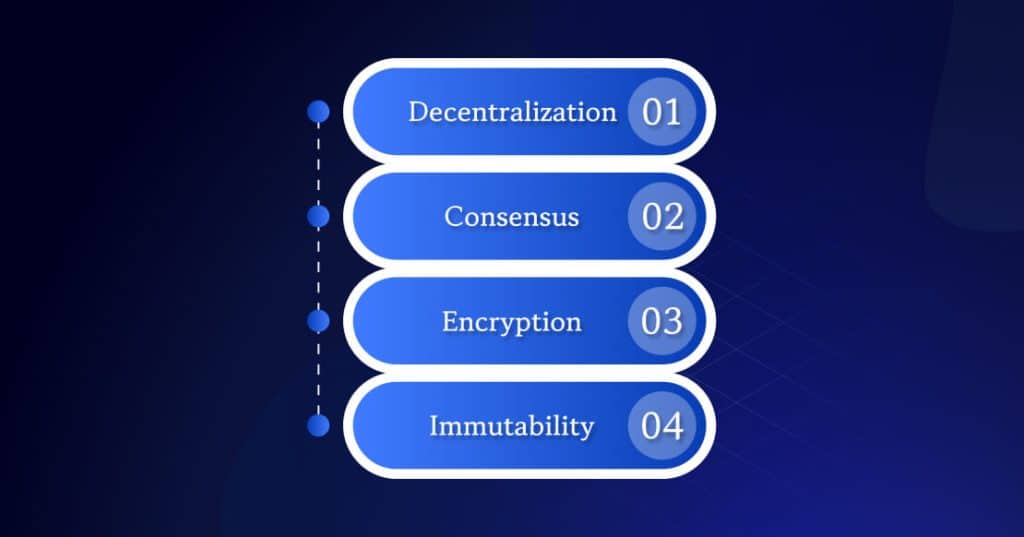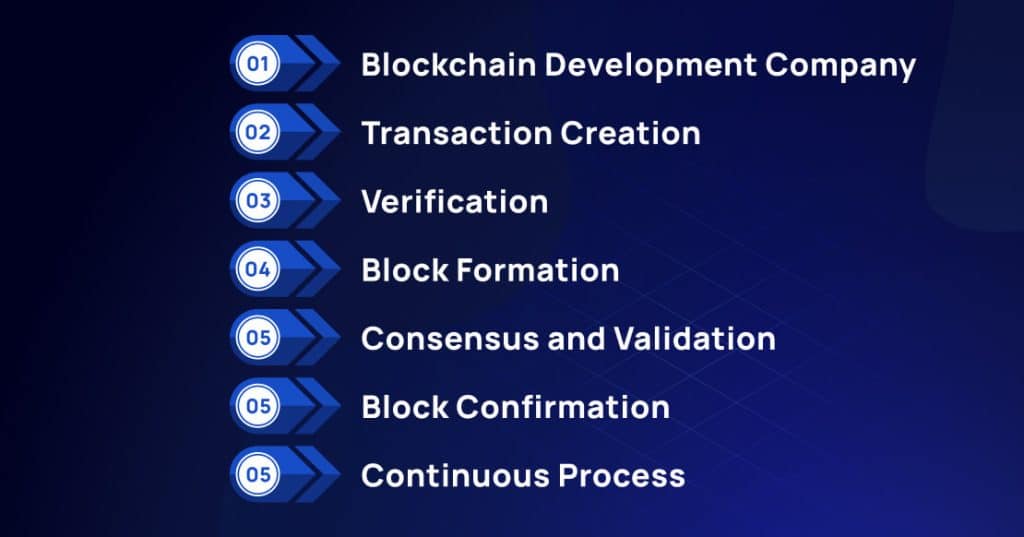Blockchain technology has become revolutionary in the world of finance. It was initially developed as the backbone for Bitcoin’s operations during the global financial crisis of 2008. Blockchain’s distributed ledger technology is a secure and reliable way of transferring and storing data.
Blockchain is a public ledger that records the source of movement, transfer, and origin of valuable assets. In contrast to traditional systems that rely on central agencies, Blockchain requires unanimity approval from each node to handle transfers or payments. Blockchain Technology solves the financial sector’s major issues, specifically regarding security and efficacy.
The BFSI (banking, insurance, and financial services) sector is now a significant adopter of Blockchain, making up 38% of world market value. Although Blockchain’s value was initially restricted to crypto and fintech, conventional financial institutions have adopted this new technology.
Digitization of Financial Instruments Impact Finance
Digitalizing financial instruments—including smart contracts, digital assets, and programmable currency—takes Blockchain’s advantages to the next level by creating unprecedented connectivity and programmability among assets, services, products, and holdings. Digital instruments will revolutionize the business and financial market, establishing a new model where value is generated through every interaction.
Digital financial instruments can provide the following benefits to businesses:
- Security and Authenticity: Digitization ensures data integrity and provides the asset’s provenance and complete transaction history as a shared source of truth.
- Programming Capabilities: Code dealing with governance, compliance privacy, data security, identity (KYC/AML attributes), system-wide incentives, and features to manage stakeholder participation (for voting rights and various other privileges) could be integrated into the assets.
- Streamlined Processes: Increased automation improves operations’ overall efficiency. It permits the use of real-time settlement, audit, and reporting. It reduces processing time, the possibility of errors and delays, and the number of intermediaries and steps needed to reach the same level of assurance when using traditional methods.
- Economic Benefits: The automated, more efficient processes result in lower operating costs, infrastructure expenses, and transaction costs.
- Market Reactivity: Digital securities permit greater flexibility than traditional securities and can be issued for shorter periods. Issuers can design bespoke digital financial instruments that can be directly matched to investors’ needs.
- New Products and Markets: Secure, scalable, and quick asset transfer, fractionalized ownership of actual-world objects, tokenized microeconomics, and much more.
Together, these advantages are reflected in more transparent, accountable governance systems as well as effective business model designs, enhanced incentive alignment among the various stakeholders, more liquidity, lower cost of capital, a reduction in risk of counterparty Access to a broader capital and investor base as well as access to other financial instruments that are digital.
How do Blockchains Work? A Brief Outline

Blockchains function as databases. They are made up of cryptographically encrypted blocks linked to one another.
The blocks contain information about the parties involved in the transaction. Blockchain can track transactions without identifiable information and instead use a digital signature.
The data stored in the Blockchain will also contain data that differentiates it from other information. It will be stored with the unique code known as hash that allows it to distinguish each data unit.
For instance, if you buy the same item twice on a site and make two purchases, different codes will be used to categorize every transaction. Blockchain can keep up to 1MB of information per block. A single block can contain several thousand transactions.
The primary characteristics of a cryptocurrency that allow its use are decentralization, encryption, consensus, and the ability to change.
Decentralization
In contrast to traditional centralized systems, where one entity is the sole database controller, Blockchains are decentralized. They are maintained and upgraded by a group of participants, also known as nodes. These participants verify and store the Blockchain data.
Every node replicates the whole Blockchain, guaranteeing redundancy and removing the necessity for a central authority.
Consensus
The ability to reach a consensus among network participants is essential for Blockchain security. Consensus mechanisms ensure that the participants agree regarding the legitimacy of transactions and the order in which they’re being added to the Blockchain.
This stops double-spending, fraud, and other fraudulent actions. Diverse consensus algorithmic models, including Proof of Work (PoW) or Proof of Stake (PoS), ensure consensus and verify transactions.
Encryption
Blockchain uses cryptographic techniques to protect data and transactions. Every transaction is encrypted and linked with the prior transaction using an algorithmic hash function.
This results in the appearance of a chain of blocks, each with a unique hash that proves its integrity and location within the overall sequence. Any alteration to a block could alter its hash, alerting the network of the attempted tampering.
Immutability
When a transaction is included in a block and incorporated into the Blockchain, it is virtually impossible to modify or erase. The blockchain’s decentralization and cryptographic hashing guarantee the indestructibility of the recorded information. This feature provides a high degree of transparency and trust since the history of transactions can be retrieved and examined by anyone with an access point to the Blockchain.
How Blockchain is Changing the Banking Industry?

Blockchain technology has led to significant developments in fintech and other industries over the last few years. Blockchain allows non-trusted parties to agree on the state of a database without relying on a middleman to conduct transactions.
The ledger is one that no one manages. It can provide financial services, such as payment, without using any other third party, like banks.
This creates decentralization that could allow banks to concentrate on other tasks besides tracking transactions.
Blockchain Development Company has transformed banking in many different ways. It has affected payments, settlement systems, fundraising, credit management, securities, trade finance, and credit.
Blockchain could facilitate faster transactions and lower costs than banks by using the decentralization ledger to make payments. Blockchain impacts settlement and clearing systems, in which distributed ledgers lower the cost of operations and also facilitate faster payments between banks.
Fundraising has been transformed by offering the opportunity for Initial Coin Offerings. A new method of financing could unbundle capital access from firms and capital raising services. Securities like bonds, stocks, and other types of assets are placed on publicly owned Blockchains, resulting in more efficient capital markets.
Blockchain has transformed the banking industry by eliminating the requirement for gatekeepers within the credit and loan industry and credit industry. Blockchain has made lending money and offering lower interest rates more accessible and secure.
Trade finance has been transformed with Blockchain technology, which has replaced heavy paper. Blockchain has brought more security, transparency, and trust between trade partners worldwide.
The procedure of adding transactions to the Blockchain is accomplished by following steps:
Transaction Creation
A person initiates a transaction by creating an electronic record with relevant information such as the sender’s name, the recipient’s name, and the transaction value. The transaction is usually broadcast over the Internet.
Verification
The network nodes verify the transaction to ensure its authenticity and integrity. Verification involves reviewing the digital signatures to confirm the sender has sufficient funds and checking any other conditions specified by the Blockchain’s smart contracts.
Block Formation
Verified transactions are placed into blocks. Every block has a maximum size and may contain a certain number of transactions. It also includes earlier blocks’ hashes, linking them, and creating the chain.
Consensus and Validation
The network participants can collectively agree that the block is valid through the consensus mechanism agreed upon in the blockchain protocol. When consensus is achieved, this block is added to the Blockchain, and the transaction is an indefinite component in the ledger.
Block Confirmation
After a block is placed on the Blockchain, it is replicated across all nodes on the network. This ensures that each node runs the most current version of the Blockchain and allows them to participate in the validation process to verify future transactions.
Continuous Process
The Blockchain continues to expand with each block added, resulting in an ever-growing ledger of transactions. Every subsequent block includes an identifier for the prior block, ensuring transaction authenticity and chronological order.
Use Cases of Blockchain in Finance
Blockchain technology has many exciting applications in the financial sector, with artificial intelligence revolutionizing how we conduct business and opening up new opportunities. A few of the most well-known uses for Blockchain technology in finance include:
Smart Contracts
Smart contracts are self-executing agreements that automatically perform predefined actions when certain conditions are fulfilled. Blockchain can be used to implement smart contracts that streamline and automate various financial processes, including loans, insurance claims, and supply chain finance. This eliminates manual intervention, increases efficiency, and lowers the chance of fraud and disputes.
In the event of an insured incident, such as a flight delay, the smart contract will instantly trigger a payout to the policyholder following specific conditions. This means there is no need to process claims manually, reducing administrative costs and allowing quicker and more effective settlements. The transparent and tamper-proof characteristics of smart contracts can also prevent fraudulent claims and build assurance between policyholders and insurance companies.
Business Process Automation
Intelligent contract capabilities of Blockchain have revolutionized the automation of business processes in the financial industry. Smart contracts execute themselves that are written into code. They can automate and streamline various financial procedures, from approval of loans to insurance claims processing. The advantages are evident in terms of efficiency and significant cost savings. In instances like settlements for insurance claims, smart contracts have resulted in the possibility of a fivefold decrease in expenses and three times faster claims processing.
Additionally, smart contracts can define the terms of nearly every legally binding financial contract and ensure that certain business decisions are enforced automatically. Proxy contracts have solved the problem of updateability for smart contracts, allowing for flexible changes to the contract’s logic when the agreement changes terms.
Trade Finance
Blockchain makes it easier and faster to process trade finance procedures like credits and letters by offering a safe and transparent platform for everyone involved. It allows for the real-time monitoring of products, improves trust between parties, simplifies document verification, and increases the overall efficiency of international trade.
One of the best examples of Blockchain’s impact on trading finance would be that of the Marco Polo Network. It’s a network of technology and financial institutions and businesses that use Blockchain technology to simplify the process of financing trade. The network provides solutions to open-account trade invoice finance and risk management. Through digitizing trade documents and automating verification procedures, Marco Polo Network reduces the time and complexity involved in trade finance transactions. Marco Polo Network minimizes the duration and complexity of financing transactions for trade.
Know Your Customer (KYC) and Identity Verification
Blockchain technology can help improve your KYC process by storing and sharing customer identification data with financial institutions. This helps reduce the amount of work, improves the customer experience, and helps ensure compliance with regulatory requirements compliance while ensuring the confidentiality and security of sensitive information.
One Blockchain-based example of KYC or identity verification would be that of the Sovran Network. Sovrin is an open, decentralized self-sovereign identification platform allowing users to control their data. It lets users securely keep and manage their identity information on the Blockchain, such as documents and proof of identity. This removes the requirement for repeated KYC procedures and allows for an encrypted and secure identity verification.
Supply Chain Finance
Blockchain provides greater clarity and security in finance for supply chains by securely recording and verifying transactions relating to product transportation. It allows real-time tracking, authenticating products, and the secure transfer of ownership, decreasing fraud, improving the traceability of goods, and providing efficient financing options for supply chain participants.
IBM Food Trust illustrates a Blockchain-based system changing the way supply chain finance is conducted. Its primary focus is on improving transparency and traceability within the food industry. Utilizing Blockchain technologies, this platform lets people follow the path of food items from the farm to the customer. Providing reliable and accurate supply chain data can help reduce the risk of foodborne illness, increase food safety, and facilitate more efficient financing options.
Auditing and Regulatory Compliance
Blockchain technology’s immutable and transparent nature allows for more efficient auditing and compliance with regulatory requirements. Financial institutions can keep extensive and secure records of transactions, which facilitates audits and reporting requirements for regulatory agencies. Smart contracts can also automate the enforcement of compliance regulations, decreasing the possibility of non-compliance.
Deloitte and Ernst & Young (EY) are two of the most prominent companies using Blockchain technology for auditing and compliance with regulatory requirements. Both firms have created Blockchain-based solutions to facilitate efficient and transparent auditing procedures. These solutions allow immediate access to financial data, automate auditing processes, and improve the reliability and accuracy of auditing findings. Blockchain’s immutability assures the authenticity of audit trail records, makes it easier to complete reporting for regulatory purposes, and lowers the chance of fraud in financial transactions.
Crowdfunding and Peer-to-Peer Lending
Blockchain is a decentralized crowdfunding and peer-to-peer lending platform that eliminates the need for intermediaries and allows borrowers to connect directly with lenders. This reduces costs and improves transparency. Additionally, it will enable businesses and individuals to get funding from a global collection of investors. Blockchain-based crowdfunding platforms also offer better protection for investors and guarantee an equitable distribution of the funds.
An excellent example of Blockchain-based crowdfunding and peer-to-peer lending can be found on the platform SALT (Secured Automated Loan Technology). SALT lets individuals use Blockchain-based assets such as cryptocurrency as collaterals to secure loans. This means there is no need to use traditional checks for credit, allowing customers to obtain funds quickly. Blockchain technology guarantees transparency, facilitates peer-to-peer transactions, and decreases the dependence upon traditional institutions for financial services.
Government
Blockchain is a hot topic in politics and government. Many instances of government use of Blockchain enhance the quality of government services, protect citizens’ property rights, reduce bureaucracy, and improve transparency.
Governments worldwide, including Dubai, China, and even the US, are investigating the possibility of using Blockchain to improve the quality of life for their citizens. However, the current trend of Blockchain adoption is mainly limited to Ethereum.
Here are a few examples of how various governments use Ethereum Blockchain to better their nation.
- Dubai is preparing to be a fully integrated Blockchain city by 2020.
- Estonia developed into a ‘digital republic’ by transferring various national systems to Ethereum Blockchain.
- Chile uses Ethereum to trace the data and finances from the energy grid to stop corruption and exploitation. It does this by making the information available for citizens to access.
- Canada is currently testing the platform to give information on how the government uses grants to ease citizens’ fears of misappropriation and corruption.
The Key Takeaway
Blockchain technology is undoubtedly among the most exciting technologies of our times and is poised to transform many industries. It offers a secure and decentralized method of keeping and sharing data, which can change how people conduct transactions, control personal information, or even participate in elections.
Despite the difficulties associated with implementing Blockchain-based solutions, businesses and companies willing to invest will benefit from greater transparency, efficiency, and security. With the proper plan execution, collaboration, and implementation, Blockchain technology could be the most effective way to open new possibilities and bring technological innovation in the digital age.
Frequently Asked Questions
Suppose we focus on the various industries in which the application of Blockchain technology will be the most evident. In that case, the names emerging in the background include Healthcare, Manufacturing, Government Retail, Healthcare, and Enterprises. The case studies will focus on the usual benefits that the technology offers.
Two possible uses of Blockchain in the banking sector are A. reducing the risk of fraud and B. creating an immutable and transparent KYC process.
Cryptocurrency is just the surface of Blockchain technology’s capabilities. The advantages of this technology extend beyond the digital currency. Based on its various benefits, like decentralization, transparency, immutability, and so on, Blockchain is currently being utilized in case studies and by businesses that go beyond the coin.
In the government’s setup, Blockchain is being used to help intelligent cities meet their data requirements, such as the property record, KYC of nationals, and the details of citizens in an immutable distributed ledger.
The application of Blockchain in the real estate sector is mainly thought of as keeping property records on an open ledger that speeds up the process of paying using smart contracts and digital currencies for managing contracts, deeds, agreements, etc.
